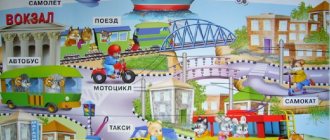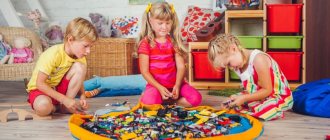Didactic games for speech therapy classes with preschoolers
Speech therapy educational games for preschoolers
Educational games Author: Tatyana Vasilievna Chervyakova, speech therapist, MDOU kindergarten “Rodnichok” Description: The presented didactic games will be useful for speech therapists and kindergarten teachers. The material is intended for conducting individual and subgroup speech therapy sessions with preschoolers.
Purpose of the game: to activate vocabulary on the topic “Vegetables” and “Fruits”; Teach children to divide words into syllables. Material: drawings: planar images of baskets with syllabic patterns, images of objects - vegetables and fruits. Progress of the game: Speech therapist. Guys, today we are going to visit our grandparents in the village to see what vegetables have grown in the beds. – And then our grandparents meet us.
Speech therapist. Grandma invites you to guess what vegetables they collected. – round, red, juicy, healthy, soft... (tomato) – oval, green, crunchy, rough, hard... (cucumber) – oblong, orange, hard, tasty, vitamin... (carrot) – round, bitter, hard, healthy ... (onion) - round, green, juicy, crispy... (cabbage)
Speech therapist. Guys, you guessed all the vegetables. Now let's put them in baskets. – Notice what beautiful baskets grandma prepared. Each basket has a syllabic pattern. Let's name the vegetables one by one, determine the number of syllables in each word and put the vegetable in the correct basket.
A similar game can be played on the theme “Fruits”. As material we use images of objects - fruits.
Didactic game “Syllable Houses” Purpose of the game: to teach children to break words into syllables. Material. Airplane images of houses with window pockets. Every house has a syllabic pattern. Images of objects depicting fairy tale characters: Wolf, Carlson, Dunno, Pinocchio, Malvina, Puss in Boots and others. Progress of the game. Speech therapist. The heroes of fairy tales came to visit us. Nominal. Child. Wolf, Carlson, Malvina, Pinocchio, Aibolit.
Speech therapist. Guests should be “settled” in houses. Determine the number of syllables in each word and “place” the hero in the desired house.
Child (speak and emphasize the syllables) - “Karl the Son” - two syllables (puts the photo in the pocket of house No. 2) - “Wolf” - 1 syllable (puts the picture in the pocket of house No. 1).
- “Mal-vi-na” - this word has three syllables (puts the picture in the pocket of house No. 3) - “Bu-ra-ti-no” - the word has four syllables (puts the picture in the pocket of house No. 4)
Speech therapist. Very good! The manual can be used when studying other lexical topics.
We recommend watching:
Speech therapy games for preschoolers Games for the prevention of optic dysgraphia and dyslexia in preschoolers Speech therapy games for kindergarten using animals Do-it-yourself speech therapy board games for kindergarten
Similar articles:
Speech therapy games for preschoolers and primary schoolchildren
DIY speech therapy games for preschoolers
DIY speech therapy games
Speech therapy game for older preschool children
Speech therapy game for children 5-8 years old “Who is faster”
Norms of speech development at the age of 2-3 years
Speech development occurs between the ages of 0 and 3 years. Normally, this happens in several stages, and parents should understand them. In the period from 0 to 1 year, onomatopoeia and babbling become more active in the child’s speech. By the age of one year, the first words appear; there should be from 10 to 25 or more. The baby understands spoken speech, follows simple instructions, and knows the names of objects in the surrounding space. By the age of two, coherent speech is actively developing. Words form a sentence. In the third year of life, the baby begins to be interested in the world around him, and his vocabulary is actively expanding. Phrases become detailed and grammatically correct, and word creativity appears.
Lesson on speech development at a preschool educational institution
The role and significance of speech therapy games
The process of further development of the child depends on how well the speech is formed. That is why it is so important to promptly prevent various defects and monitor the purity of the sounds produced by the baby. Violations are noted not only in the speech of a preschooler, but also in perception and production itself. When determining the degree of the defect, all symptoms associated with mental, physical and speech development are identified.
Language educational games
Note! Play is the main activity of a child; with its help, he masters various forms of thinking and develops his horizons. Speech therapy games play an important role in creating a favorable environment for a child to overcome speech disorders of varying severity.
Speech therapy educational games for preschoolers have great potential: with their help, the student works on correct pronunciation of words, learns their native language and learns the rules of grammar in a simple form. Difficulties overcome in this way in a playful way are less obvious and tangible for the child.
The main significance of speech therapy games is to increase the vocabulary and horizons of children, expand the boundaries of the child’s consciousness and introduce him to the world around him.
How games help a speech therapist
Every year the percentage of preschool children with speech pathologies of varying complexity and etiology increases. To correct standard speech disorders, you need to practice at least 2-3 times a week for 30 minutes. However, it is difficult to captivate children with a monotonous task; they quickly get tired and refuse to complete the exercises suggested by the teacher. To increase motivation for learning, speech therapists use game techniques in their classes, thanks to which the correction process ceases to be boring for the child.
What else to read: Card index of didactic games and exercises for kindergarten on sensory development of young children
Speech therapist and child
Gross motor games
A child’s speech is an indicator of his overall development. A lot has already been said and written about the interdependence of speech activity and motor skills. Working on the development of motor skills allows you to correct speech disorders and stimulate the speech development of children by improving the child’s thinking.
Game "Bunny"
The little gray bunny sits and wiggles his ears like this, like this and wiggles his ears.
(The child uses his hands to depict bunny ears.)
It's cold for the bunny to sit. We need to warm our paws. Like this, like this. We need to warm our paws. (The child rubs his palms together.)
It's cold for the bunny to stand, the bunny needs to jump. Like this, like this The bunny needs to jump! (The child jumps, pretending to be a bunny) .
To play, you can use a soft bunny toy.
Speech therapy games with a flashlight for children
Games with light are spectacular and exciting, and the flashlight is accessible and safe for children. The game was developed by teacher Natalya Konyakhina. For the game you will need sheets of paper from which the box will be made. You will also need drawings that can be printed on a printer or downloaded from the Internet (shoes, clothes, fruits, vegetables, animals and any other items studied in preschool). Items need to be cut out and glued inside the box so that the front side faces the baby. The child points a flashlight at the wall and answers the questions: “What do you see?”, “Whose shoes are these?”, “Is there an apple in the box or many?”
Underdevelopment of phonetic-phonemic speech in preschool children
Note! Games with a flashlight make it easy for a preschooler to develop coherent speech.
Child with a flashlight
Fine motor games
Fine motor skills are a universal way of speech development in children. If you specifically train hand movements, speech development in preschool children is accelerated, because speech areas in the cerebral cortex are formed by receiving impulses from the fingers.
Game "Goat"
The goat needs to get to the haystack on the other side of the river. The task is to help her get to the other side by building a bridge. I would like to note that children respond very emotionally to a request for help, even from a drawn goat. To build a bridge, you can use coffee beans, buttons, cinnamon sticks, beans, and cereals.
“Go, goat, go! Here. There’s hay there,” says the teacher and the child.
Didactic games for the development of speech of preschoolers card index on speech therapy on the topic
Reminder for parents
“We talk, we play – we develop our discourse”
DEAR PARENTS!
Talk to the kids!
There is a lot of talk about how good language development is a prerequisite for academic success. However, parents do not always know how to develop this speech.
You can often hear: “We read a lot to the child, read poems, talked about everything, but there was no result; The child himself cannot describe the simplest image or tell anything.”
How could it be otherwise: after all, it was the parents who said it, not the child. Babies are all different - some are unstoppable, while others say nothing. But even the “silent” will speak if there is an incentive to speak out.
The performance begins with the desire to communicate!
No matter how imperfectly your child speaks, accept his desire and indulge him. Even if he doesn't speak at all, often engage him in nonverbal dialogue, welcoming and approving any response (gesture, expressive look). At the same time, try to give him the opportunity to listen to himself and himself. Especially create play situations where the child will need onomatopoeia or will have to say a few words for the game to take place. Keep in mind that it is not you who motivates, but the situation. Mood.
Try to pronounce a new word in an emotionally favorable situation: when the child is calm, in a good mood, in such conditions the child assimilates and assimilates information 10 times better than neutral or unfavorable information.
How can you develop speech?
1. Whether you are looking at an image, reading a book, draw your child’s attention to rare phrases, ask what this or that word means.
2. Play the game “Tell Me the Word”: an adult reads a short poem, and the child must guess and name the last word in it.
3. Play with words. This can make a long journey in transport, or the need to lie in bed, cheer up. These tasks include:
- what words, colors can describe the time of year, tell about the topic, what it is about (quote as many adjectives as possible);
- what he can do (name as many verbs as possible)
- play a bad and a good game. What is good about Baba Yaga and what is bad? What is good in the rain and what is bad?
- play opposite words (opposites)
4. Invite your child to tell a story, story, or cartoon. Ask what you liked and why. Ask to describe your favorite character.
5. Play the game: “Find the error in the sentence”
6. Teach your child to make a story from an image. Explain that a story has a beginning (as short as the morning), a center (as the day), and an end (as short as the evening).
7. Play a familiar fairy tale face-to-face with different intonations.
Remember! It's very easy to knock over a child. Treat your child with understanding.
Expand your child's vocabulary.
A child has words on two levels: he understands words - this is passive vocabulary, he speaks - he is active. The active vocabulary can be quite small. Try entering the names of things around it (toys, household items), the names of family and friends into the active dictionary. More often they ask: “Where is the table? Where's the clock? ”etc. This will certainly lead to an increase in vocabulary. Develop phonemic awareness (the ability to hear different speech sounds) by encouraging different sound words. (roof – mouse, nose – knife).
Read to your child.
Read short poems and fairy tales. Read them many times: don’t be afraid that your child will get tired of it. Children learn much better from texts they have already heard. If possible, try to quote the poem - show it with faces and objects; and let your child play with objects. Wait until the child has a good memory of the poem, get a feel for the rhythm, then try not to finish the last word of each line, allowing the child to do so. Sing simple songs to help him feel the rhythm and play it.
What else to read: Didactic games for developing tactile sensations
Fingers help the word.
Pay attention to the development of fine motor skills - precise finger movements. Modeling, drawing, finger theater, playing with small objects - all this will help speech, and in the future, writing. The child should work with naughty fingers as much as possible. No matter how boring it may seem, let the child button up his buttons, tie his shoelaces, and roll up his sleeves. It is also better to start training not with your own clothes, but first “help” the doll and even the parents get dressed. As a child's fingers become more dexterous, his speech will become more understandable to others. About the benefits of joint gymnastics in the development of a preschooler.
Joint gymnastics in the development of preschoolers.
Gymnastics for arms and legs is familiar to us. We train the muscles so that they become flexible, strong and agile. But why train? It turns out that the tongue is the main muscle of the speech organs. And like any muscle, it simply needs gymnastics. After all, the tongue must be well developed to make the subtle, intentional movements that produce speech sounds.
Pronunciation deficiencies aggravate the emotional and mental state of the child, preventing him from developing and communicating with peers. To prevent this problem from arising, you should start doing gymnastics for your joints now. With the help of articulatory gymnastics, existing violations of sound pronunciation are overcome.
At first, gymnastics should be done in front of a mirror. The child must see what his tongue is doing and where it is. In this case, the movements of the tongue are brought to automaticity by constant exercises. Work with your child every day for 5-7 minutes. Carrying out articulatory gymnastics in the form of a fairy tale (in a funny language) will help turn the exercises into an exciting game.
Believe in yourself!
Remember: only you and your faith in the child’s strengths and abilities can help him develop harmoniously. Be patient, kind and calm and you will succeed.
Development of fine motor skills to prepare the hand for writing.
It has now been shown that the development of fine motor skills of the fingers has a positive effect on the speech development of children. Employees of the Institute of Physiology and Adolescence of the Academy of Pedagogical Sciences of the Russian Federation determined that the projection of the hand to the brain is very close to the area of the speech motor. The relationship between the motor and speech zones is also manifested in the fact that a person who has difficulty finding a word helps himself with gestures, and vice versa: a child focused on drawing or writing involuntarily sticks out his tongue.
Therefore, training the movements of fingers and hands is the most important factor that stimulates the development of a child’s speech, helps improve articulatory movements, prepares the hand for writing, as well as a powerful tool that increases the performance of the cerebral cortex and, as a result, the level of development of thinking.
Activities that develop fine motor skills.
Have a beneficial effect on the development of hand and finger movements:
- massages and self-massage;
- finger gymnastics;
- visual activity;
- modeling;
- drawing;
- statement;
- handmade;
- manipulations with various objects: collecting pyramids, nesting dolls, builders, mosaics; unfastening and fastening buttons, Velcro, straps; lacing.
- shading, writing.
Games and exercises for children 2-4 years old.
Magic bag.
Examine toys and objects with your baby and touch them. Invite your child to touch one of the items in the bag, name it, and pick it up. Without removing the object, touch it, name it and describe it.
Tactile tables.
it is necessary to prepare a series of boards with different structural surfaces; with images of various objects cut out along the contour.
Tasks: with eyes closed, feel the outline and name the depicted object; find a specific image of an object with your eyes closed; find two identical cards.
Finger pool.
Tasks: lower your hands to the pool of fingers and touch the beans or peas; move to another container one by one; clench and unclench fists with beans and peas while holding hands in the pool; touch this object.
I turn and turn.
(Tasks with various massage balls, sticks, chestnuts, nuts, etc.)
Throw and grab an object with one hand, two hands, unfold an acorn or pine cone. Roll a massage ball or stick: with your palm, the edge of your palm, the finger of one palm towards the other, between your palms, on the back of your hand with rotational movements in one direction, in the other direction, vertically. Gradually increase pressure and rotation speed.
Rope.
Tasks: tie and untie knots; twine: remove the beads, twist the lace between the tips of the thumb and forefinger, wind the lace on a stick or thread on a spool, braid a pigtail, intertwine fingers with lace, decorate patterns and figures with lace.
Clothespins.
Tasks: use clothespins to hook a sheet of paper, the edge of a box or cup, or a rope; open and close the clothespin with your thumb and index finger, thumb and middle finger, etc. Ask your child to count the number of clothespins on the string, and only put clothespins of a certain color on the string.
What else to read: “Didactic game as a form of teaching children of primary preschool age”
Exercises with vocal accompaniment.
Fox.
Rhythmic opening and closing of a clothespin while pronouncing the text:
“Clever scammer, redhead. The mouth opens, it scares the rabbits.”
Crow.
Bend your hand towards the table and take the candy wrapper. Then the brush returns to its original position. Talk:
“I saw the paper and how to take it. I thought it was candy, but it turned out to be a candy wrapper.”
Dogs.
The exercises involve both hands, which rhythmically open and close clothespins while pronouncing the text:
“Two dogs bark, don’t bite. Two cubs walk around in the nest all day, screaming, opening their mouths to the crows, and really want to eat.”
For children 5-7 years old.
Finger gymnastics, games with letters and words. As a physical exercise, it is very good to use finger exercises with speech accompaniment. The dictionary has dozens of poems on every topic. For example:
The sky in Russia is blue
The rivers in Russia are blue – they bend like your finger.
There are maples and oaks, the fingers represent “branches”
What kind of mushrooms are there? The fist of one palm is covered with the other open palm.
Children love to speak in a secret language. Create your alphabet with your fingers. Use it to guess letters and then form words. [2]
Arrange the figures, counting sticks and matches.
Finger Theater. They develop attention, thinking, memory, stimulate the baby’s speech development, help relieve tension from the hands and lips, relieve mental fatigue, develop arms, become more mobile and flexible. Advise parents to take their children to a real theater to see various children's performances.
Written works, various types of shading, coloring of figures, pictures.
Currently, there is a large selection of literature on this topic. You can purchase it to your liking, but make sure the instructions are appropriate for your child's age and difficulty level.
In recent years, the number of children with speech disorders . And every year the number of practically non-speaking children . The reasons for this phenomenon are varied and numerous.
Unfortunately, children with speech disorders often get to see a speech therapist only before school, at best, after five years, and the most significant age for the development of a child’s speech, the age of three, turns out to be missed.
Speech therapy based on the principle of repeated repetition of material, and what could be more boring for a preschooler whose leading activity is play? And in order to arouse the child’s interest in classes, the speech therapist must introduce the maximum number of didactic games.
Play is one of the most important methods of working with preschool children. The game method of teaching helps to create an interested, relaxed atmosphere and establish a psychologically age-appropriate communication situation. In play activities, the child’s individuality is revealed, feelings of collectivism and mutual understanding are formed, and children’s .
A good, smart and entertaining game activates children's , relieves psychological and physical stress, and ensures the perception of new material.
Game is our indispensable assistant in teaching a preschooler. So, learn by playing. But how exactly? How to choose the most necessary game for a given lesson, for a certain stage of it? Of course, there cannot be an exact recipe for where, when and for how many minutes to include game material. One thing that is important here is that the games help you achieve your goal. The number of them in a lesson should be reasonable. It is necessary to think through a phased distribution: at the beginning of the lesson, the game should help organize and interest the child, in the middle it should lead to mastering the topic, at the end the lesson can be exploratory in nature. But at any stage it should be interesting, accessible, including different types
Thus, we can formulate two main tasks facing a speech therapist in his work with preschoolers.
1. A speech therapist needs to widely use games in correctional work, while remembering their importance in general as a means of physical, mental, moral and aesthetic education of children .
2. When conducting the game, the speech therapist must take into account the possible behavioral characteristics of children with various speech disorders.
The main training from speech therapists comes through exercises on pronunciation and speech development. But you need to remember one important rule! It’s better for your child to leave your lesson without finishing the game than after overplaying it. Thus, a deficit of play and the child will definitely want to return to class and will do it with pleasure.
What is the significance of the game in educational and speech therapy work with children ?
The literature on preschool pedagogy and psychology has accumulated significant material indicating that play is the main activity of a preschool child, one of the characteristic patterns of child development. Play as a form of child activity contributes to the harmonious development of his mental processes, personality traits, and intelligence.
How are games used in speech therapy work ?
therapists to carry out correctional work with preschoolers through play is obvious. The work of a speech therapist requires the use of gaming techniques to an even greater extent than in conventional educational activities. The presence of a speech defect leads to changes in the mental sphere, namely the appearance of such traits as increased irritability, excitability, isolation, etc.
In modern methodological literature on speech therapy , various games are recommended when working with preschool children. The authors of methodological literature strongly recommend the use of games to correct speech disorders in children . In many cases, examples of such games are given, which are modified versions of games well known in preschool pedagogy, but they are often invented by the authors themselves.
As a rule, the bulk of games and game aids are aimed at automating sounds and developing coherent speech in preschoolers. But since I work with children with SLI, I also need to cover vocabulary and grammatical structure of speech. Therefore, the basis of this methodological development was the systematization of games and gaming aids necessary for teaching senior preschoolers with STD. Here we will present the author's developments of games tested in practice, as well as games already presented in modern methodological literature.
Increasingly, in the senior and school-preparatory groups of kindergarten, children are diagnosed with SSD (severe speech underdevelopment). This is a systemic disorder in which , phonemic perception, syllable impaired , speech is saturated with agrammatisms. Children have a poor vocabulary. Coherent speech suffers. There are also deviations in the development of motor skills, both general and articulatory.
As a result, children encounter difficulties in the learning process and poorly assimilate program material. In this regard, there is a need to use effective methods of teaching and correctional work that ensure that children successfully master the knowledge, skills and abilities provided for by the program, and play comes to the rescue and the direction of correctional work becomes important. The advantage of the game is that it allows you to more actively influence the child. With the help of games, a strong interest in classes, a desire to learn new things and assimilate knowledge and skills are maintained.
Technological component.
Games aimed at developing fine motor skills.
1. PALM. The contours of the palms are drawn on a sheet of paper. Each page contains a different position of the palms (fingers together, apart, bent, etc.) The child, placing his palms, must repeat the image as accurately as possible.
2 ROLLING THE BALLS. Children roll small balls around the table (along the playing field on which you can draw different paths - straight, curved, spiral). During the game , the ball should not slip out from under the palm and should roll exactly along the path. Balls can be rolled either with your palms (in the first games) or with one finger (in subsequent games).
3. SORTING SMALL ITEMS. It is very important that the baby does this either with a pinch (with three fingers), or using the “tweezer grip” method (grabbed with two fingers - the thumb and forefinger). At the same time, the other fingers should be tucked in and not interfere. Show the baby the correct way to do this exercise. You can sort by color (if you mixed beads of two colors, by shape, by size. Sorting small items is very important in the third year of a child’s life.
4. KNEADING PLASTICINE. This is a very useful exercise for developing fine motor skills.
5. STRINGING RINGS ON THE PYRAMID ROD. First, the baby learns to disassemble the pyramid toy (this is easier), and only then assemble it. Please note - even the smallest children easily remember the sequence of colors in the pyramid and assemble it simply from memory, and not from comparing values. Therefore, if you want to teach them to compare size of the rings and arrange them from largest to smallest sequentially, then you need a pyramid with rings of the same color!
6. GAMES – LACES . These games quickly get boring for the baby. Therefore, it is better if you have a doll whose shoes or clothes are tied with a lace.
7. PRESSING SMALL OBJECTS INTO PLASTICINE (beads, seeds, shells, small pebbles). This way you can make paintings - mosaics on plasticine.
8. SPINNERS. First, the baby learns to launch a spinning top, and then large-sized tops. And after that, give your baby small tops. Instead of a top, use any other objects: pyramid rings, balls, plastic bowls, etc. It is also useful to wind wind-up toys with a key.
9. UNPLOCKING AN OBJECT WRAPED IN PAPER – SURPRISE – “WHAT’S THERE?” When the baby unrolls the paper and finds the gift and plays with it, wrap it again - hide it in another paper. And try to find again. Teach your child to wrap - to hide an object from an older sister or brother, dad, or grandmother. Let them rejoice when his surprise is unwrapped.
10. FILLING THE BOTTLE WITH SMALL ITEMS. You can put beans, pebbles, and balls into a plastic bottle.
11. TURN THE PAGES OF THE BOOK ONE AT A TIME. This exercise is available to children from one year onwards. To do this, the pages of the first book must be thick, made of cardboard.
12. ROLLING THE PENCIL BETWEEN YOUR PALM. First, try rolling the pencil on the table with your palm. Then show your baby how to roll a pencil between straightened palms in his hands (the pencil is in a vertical position). You can glue a picture to the end of a pencil that will spin.
13. FINGER FOLK GAMES .
Development of articulatory motor skills
To present the exercise to preschoolers in a non-boring way, we select pictures and poems for each exercise.
Games aimed at developing and activating vocabulary.
1. ADD A WORD
Several people play. The first one names an object. The second repeats this word and adds one of his own, the third repeats the first two in order and names his own, etc. until someone gets confused. The game promotes the development of voluntary attention and memory.
2. VERBAL DOMINO
Several people play. Everyone takes turns pronouncing any phrases, but with a certain condition: each next player begins his phrase with the last word of the previous player’s sentence.
3. SIGNS OF WORDS
The child is told:
1st option. “Now I will name the words, and you must tell me what this object can do. For example, a blizzard is blowing, and thunder is ?; wind -. , and snow -. ; rain - and sun -. With each answer the child is asked: “What else does the sun do, because it not only shines?” The child must choose as many words as possible that denote the action. The same game can be played in reverse: “Who flies? Who swims? Who hammers the nails? Who catches mice?
2nd option. “Name another object that is as white as snow” (as narrow as a ribbon; as fast as a river; as round as a ball; as yellow as a melon, etc.).
3rd option. “Compare by taste - lemon and honey, onion and apple, by color - cloves and chamomile, pear and plum, by strength - rope and thread, stone and clay, by width - road and path, river and stream, by height - bush and tree, mountain and hill."
4. WORDS ARE FRIENDS
The child is asked to choose synonyms for the given words:
1st option. How can you say differently about a sad person? (Sad, upset.)
2nd option. What word can replace the word “horse”? (Doctor, horse, cup, food, etc.)
5. FOUR ONE
The child is asked to determine which word is superfluous, not suitable for other words, and explain why:
Sad, sorrowful, dejected, deep;
Brave, loud, courageous, daring;
Weak, brittle, long, fragile;
Strong, distant, durable, reliable.
If a child does not understand the meaning of a word, it should be explained to him.
6. WORDS ARE FRIENDS
The child is asked to choose antonyms for the named words. He is given the task: “Say the opposite: cold, clean, hard, thick, dull, spacious, wet, older, bright, enemy, top, lose, raise, winter, tomorrow, early, close, low, rare, slow, joyful, dark, sat down, took it, found it, forgot it, dropped it, messed it up, straightened it out, light, tall, sick.”
7. REDUCTION
The child is asked: “What will the name of the small object be?” Example: “A small ball is a ball, a small table is. , and so on".
8. NAME THE CHILD
The adult names the adult animal or bird, and the child must name the baby . The game is played at a fast pace.
9. FIND THE WORD
The child is told that there are words denoting living things - people, animals, birds, and there are words denoting inanimate objects. He is asked to name living words, then non-living ones.
Games aimed at developing the grammatical structure of speech.
Didactic games for the formation of grammatical structure of speech can be divided into three main groups:
Games and exercises for inflection:
- they learn to use case forms correctly, the most difficult of which for them is the genitive plural, games : “What’s missing?”, “What’s missing from the doll?”, “Paired pictures”, etc.
- use indeclinable nouns such as coat, coffee, radio, kangaroo, games “Atelier”, “Cafe”, etc.)
- correctly coordinate adjectives with nouns in gender, number, case and coordinate with verbs and prepositions. (“Which, Which, Which?”, “Who is doing what?”, “Guess what it is?”, “Tell about the subject”).
- distinguish verbs by aspect, person, number, tense, gender and mood. A special place is occupied games for the correct use of so-called “difficult” verbs: want, call, run, etc. ( games “Do you want? - We want”, “Hello, hello.”, etc.).
Games and exercises for word formation:
Didactic games for word formation can be divided into 4 subgroups:
Formation of baby animal
Formation of profession names
Formation of names of dishes
Formation of cognates
In the field of word formation, preschoolers are taught to create new (same-root) words using:
· suffixes: hare - bunny, bunny;
· prefixes: sew - sew on, sew up, embroider;
mixed method: tabletop, running, running, etc.
The learning process includes games that help to understand the change in the meaning of a word depending on word-formation shades: mustache - mustache - mustache; cat - cat - cat. The teacher teaches the children to form adjectives from the stems of nouns: What kind of raspberry jam? From strawberries? From currants?; and the formation of possessive adjectives (the meaning of belonging).
Games and exercises to improve the syntactic side of speech.
Mastery of the syntactic structure of speech occurs in the process of verbal communication, where the main methodological technique is the teacher’s questions: “Why?”, “Why?”, “What would happen if...”.
An important means of developing preschoolers’ skills in constructing sentences of different types are special games and exercises : “Complete the sentence”, “Complete the sentence”, “Who should we take for a ride?”, “Blurred letter”, etc.
Games aimed at developing coherent speech
Game “Write a sentence”. The teacher offers the group 2 cards from children's lotto, which depict objects. The group sits in a semicircle, and in turn, each child comes up with a sentence that contains the names of two planned objects. Then two other objects are shown, and again in a circle the children come up with new sentences.
Word game “Attention! Wanted! This game is played by at least 5 people. Otherwise, it’s not interesting. The presenter says: I’m looking for a friend (friend). She has blue eyes, dark long hair, loves cats and hates milk.
The one who first guesses which child we are talking about becomes the leader.
When playing with young children, it is allowed to describe clothes.
Game "Prepositions". A picture with a preposition and you need to make a sentence with it.
Game "Who is friends with which letters." Each player must have a picture of an animal. For example, one has an elephant, another has a crocodile, the third has a hedgehog. The first child says: “My elephant is friends with the letter “X” because it has a trunk.” The other says: “And my crocodile is friends with the letter “R” because he lives in the river.” The third child says: “My hedgehog is friends with the letter “I” because he has needles, etc.
Word game “Come up with a sentence with the words...” The teacher offers a word (picture), and the children make up a sentence with it.
Word game “Let’s weave a wreath of sentences.” The teacher pronounces a sentence, and the children find the last word in it and come up with a sentence with it, etc. For example: 1. Seryozha is reading a book. 2. The book is on the table. 3. My desk is clean. 4. Clean hands are the key to health, etc.
Game "Riddle and Guess". The driver (adult or child, using cards - “definitions and signs” of the word. Players try to find the hidden object. The one who guessed right becomes the driver.
Game “Make up a story.” The teacher gives each child a diagram card with conventional images: the sun, a tree, a feeder, birds and offers to compose a story on the topic “Migratory Birds” according to the diagram. Thus, stories are compiled on different lexical topics.
Game "Shop". Using models, the child describes vegetables, fruits, furniture, clothes, etc.
A didactic game is one of the forms of teaching influence of teachers on a child, at the same time, the game is the main activity of children . Thus, the game realizes educational (which the teacher pursues) and gaming (for which the child acts) goals. It is important that these two goals complement each other and ensure the assimilation of program material. A didactic game is a valuable means of cultivating mental activity; it activates mental processes and arouses a keen interest in the process of cognition in preschoolers. The game helps to make any educational material exciting, causes deep satisfaction children
How to conduct classes at home
For many children, homework is much more fun than with a specialist. The child sees his mother or any other person he knows and feels safe. To get the most out of your lessons, you can purchase special guides that not only explain in detail how to set up and automate each sound, but also record the results. An example is N.V.’s speech therapy notebook. Sokolova.
Methods for correcting general speech underdevelopment in preschool children
For your information! Initially, speech therapy games should be accompanied by a voice explanation from an adult. After this, only the child should speak (or try to speak.
Speech therapy games for setting the sounds Ш and Ж
These sounds require a flattened position of the tongue, with the tip pressed against the upper palate. This can be achieved using the following exercises:
- "Shoulder". Stick out your wide tongue and place it on your lower lip.
- "Brush". Run the tip of your tongue from your teeth to your throat and vice versa.
- "Delicious jam." He licks his upper lip as if licking sweetness.
Speech therapy games for setting the sounds L and R
Both sounds require tension of the tip of the tongue against the roof of the mouth. However, the exercises for setting up sounds will be different.
Setting the “L” sound:
- "Punish your tongue." Extend and spread your tongue over your lower lip and lightly bite it with your upper teeth, making a “roo” sound.
- Alternating “spatula” and “back”. The tongue is spread over the lower lip or tense and is in the middle of the half-open mouth.
- "Horse". The purpose of this exercise is to teach the child to click by pressing the tongue against the alveoli behind the upper teeth.
Setting the "R" sound:
- "Car". Open your mouth wide, press your tongue against the upper tubercles and quickly say “ttt”, simulating automatic fire.
- "Brush your teeth". Run your tongue behind your upper teeth to the right and left.
- "Swing for children." Open your mouth and place the tip of your tongue directly on your upper lip, then on your lower lip.
Speech therapy games for setting the sounds Z, S and C
Normally, a child pronounces whistles correctly at 4 years of age. Exercises to help reproduce these sounds:
- Alternating a smile with the “Tube” exercise. Smile widely, hold this position for a few seconds, then purse your lips.
- "Pendulum". Open your mouth and point the tight tip of your tongue from the right to the left corner.
- "Slide". Place the tip of your tongue on your lower teeth and lift the middle palate above the upper palate, forming a cusp.
Important! When explaining the exercise, be sure to have a tabletop mirror with you, in which the child will see his reflection.
Each exercise must be repeated six times, the total execution time should not exceed 2-3 minutes. When trying to correct the situation, do not put a dirty hand in your baby’s mouth. If it is not possible to purchase special tools for a speech therapist (spatula), in case of forced contact with the child’s oral cavity, you can use a teaspoon, first sterilized in hot water.
Mirror in speech therapy games
Methods for diagnosing developmental delays
Speech development does not always follow the planned scenario. Increasingly, one can observe its absence or obvious violations in sound pronunciation and grammatical structure. For a complete diagnosis of speech development, parents should seek advice from a speech therapist. The specialist will analyze the level of development of speech components: sound pronunciation, vocabulary, grammar, speech coherence.
During the examination, the speech therapist will offer the child to play with toys: pyramid, inserts, Matryoshka. During the process, a specialist will be able to identify deviations that manifest themselves in different ways. Violations of sound pronunciation are perceived by ear, just like underdevelopment of lexico-grammar.
For your information! One can often observe a picture of lack of speech at a given age.
Diagnosis and consultation with a speech therapist








